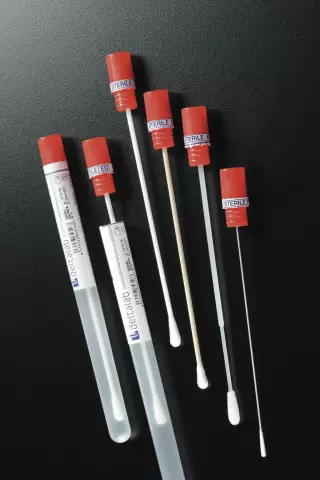- Author Curtis Blomfield [email protected].
- Public 2023-12-16 20:44.
- Last modified 2025-01-23 17:01.
If a person regularly suffers from inflammation in the throat and a runny nose, then it will not be superfluous for him to take swabs from the pharynx. This analysis allows doctors to determine which pathogens are inoculating the nasopharyngeal mucosa. By identifying the exact causative agent of an infectious disease, further treatment can be developed based on the results obtained.

A swab from the throat and nose can be administered in two cases.
1. In order to accurately establish the microbial agent that provokes the development of tonsillitis (tonsillitis) and pharyngitis. Tonsil and pharyngeal swabs are often prescribed by attending physicians to detect group A beta-hemolytic streptococcus in the collected material. It is this microorganism that most often causes a form of angina in children and adults, which causes serious complications that worsen the functioning of the joints, kidneys and heart.
2. In order to detect the presence in the patient's throat and nose of colonies of bacteria that can cause severe infectious diseases in a person. The most striking example is the appointedsmears from the pharynx with boils often developing on the surface of the body. The culprits for the formation of these boils are most often Staphylococcus aureus. Their permanent location is the mucous membrane of the throat and nose, from where they spread throughout the skin.

Faus swab technique
A throat swab is taken in the following way. The doctor asks the patient to open his mouth wide and tilt his head back a little. Next, he fixes the position of the tongue. For this, a metal plate or a wooden stick is used. It is lightly pressed on the tongue, which provides a better view of the throat. Then a sterile cotton swab is taken. They are carefully, trying to cause the least discomfort to the patient, are carried out along the mucous membrane of the tonsils and throat. These swabs from the pharynx are subjected to further analysis. The procedure itself, of course, is painless, but still unpleasant, since touching the back of the throat, as a rule, induces a gag reflex in the vast majority of people.

After taking particles of mucus from the surface of the pharynx and tonsils, the doctor places the swab in a special preservative nutrient medium. It does not allow microorganisms to die and allows them to be delivered to the laboratory for analysis, which will determine their appearance. This material can be directed to several types of research. The most commonly performed tests are:
- Buck. sowing. This method consists in transferring particles of the taken mucus to differential diagnostic orelective nutrient media. On them, bacteria begin to multiply rapidly and form specific colonies. Throat swabs taken from the patient can determine which types of microbes they belong to and which antibiotics they react to. This is very important in cases where the course of antibiotic therapy was ineffective.
- Rapid antigen tests. These are specially designed express tests that react to the antigens of bacteria of a specific type.






